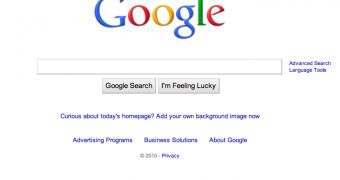To showcase a new feature, Google ran a series of photo backgrounds on its homepage internationally yesterday. The idea was to show off the new custom background feature, which had been rolled out to everyone. But several hours into what was supposed to be a 24-hour showcase, Google pulled the feature claiming that a bug left people confused about the background images.
“Last week, we launched the ability to set an image of users’ choosing as the background for the Google homepage. Today, we ran a special ‘doodle’ that showcased this functionality by featuring a series of images as the background for our homepage,” Marissa Mayer, Google’s VP of Search and User Experience, wrote in an update to the original post.
“We had planned to run an explanation of the showcase alongside it—in the form of a link on our homepage. Due to a bug, the explanatory link did not appear for most users. As a result, many people thought we had permanently changed our homepage, so we decided to stop today’s series early. We appreciate your feedback and patience as we experiment and iterate,” she explained.
Google planned to include a link saying, “Curious about today’s homepage? Add your own background image now.” But the link only showed up occasionally for some people. Users visiting the Google homepage, the most highly trafficked web page in the world, would see the new background images, but no explanation as to what they meant.
Many assumed that the change was permanent and they didn’t like it. Google’s homepage is well known and appreciated for its minimal approach to design and users, having found no obvious way to remove the images, were understandably upset.
So, Google decided to end the showcase early to appease its users. But the spotlight on the background image feature served to highlight some issues with the way it had been implemented. Critics say that elements on the page, especially text, become hard to read with some pictures. Google is using a stronger shadow for the white text to keep it separated from the images but, because of the small font size, this doesn’t always work. Of course, because the idea is to give users a choice of the image background, unlike Bing, which hand-picks all pictures, these problems were pretty much unavoidable.

 14 DAY TRIAL //
14 DAY TRIAL //